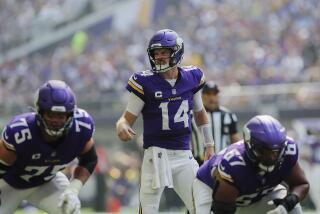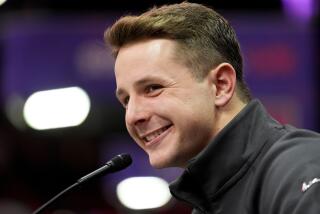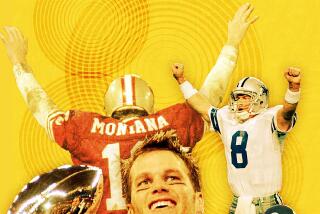This is How Jeff George Did It
Jeff George, the passer who revived the Minnesota Vikings Sunday and repulsed the San Francisco 49ers, 40-16, has always had the arm to do just that.
He is the living example of the truth that it takes more than a great arm to make a great quarterback.
At 32, George, who will see Denver and Dallas in his next two games, won his first Minnesota start because, as the new leader of a talented bunch that finished 15-1 a year ago, he doesn’t have to carry this team.
Protected by one of the league’s great blocking lines, he now only has to get the ball out there and let the four best receivers he’s ever had make the plays.
The four--Randy Moss, Cris Carter, Jake Reed and underrated Matthew Hatchette--are just what George was looking for when, in the ‘80s, he moved from one Big Ten team to another, from Purdue to Illinois; and when, in the ‘90s, he moved from one pro club to another, from Indianapolis to Atlanta, Oakland and, finally, Minnesota.
* * *
49er Coverage Irrelevant
It has been said that no position in any sport is as demanding as football’s quarterback position.
Accurate passing is but part of it, but it’s the part that George is famous for. And it was the decisive part Sunday.
Repeatedly, he could do what every quarterback longs to do: jam the ball into closely guarded receivers.
Thus, it was irrelevant that the 49ers had Moss nicely double-covered on the 25-yard sideline pass that set up Minnesota for its first score, 7-0.
Next, on an 80-yard play, George effortlessly bombed Hatchette with a first-down throw as Minnesota stepped out to 14-10.
To make it 24-13 at the half, he slipped the ball seven yards to tight end Andrew Jordan when the 49er defense was busy with three Viking wide receivers.
Finally, in a no-back, five-receiver formation in the second half, George wasn’t rushed or even hurried by any 49er when, on a third-down, two-yard play, he chose Carter to catch his other scoring pass.
* * *
49er Offense Rolls Only 3s
Although the 49ers are hopelessly deficient this year in two places--their offensive line and defensive backfield, whose trouble is the legacy of former executive Carmen Policy--their starters played as if they expected to win.
Their problem could be stated mathematically: The San Francisco offense rolled 3s--a field goal in each of the first three quarters--while Minnesota was making 7s.
The pattern was set in the first quarter when, after long drives, both sides tried to run on first and goal and both failed.
Then Minnesota gave San Francisco the old 1-2:
1. The 49ers’ pass defense buckled on George’s 10-yard, third-down throw, which led to Minnesota’s easy touchdown on fourth and a short one.
2. The 49ers’ pass protection broke down on their third-down play, which led to their first field goal near the end of the 7-3 first quarter.
The rest of the game was, for the 49ers, a continual reprise of all that.
* * *
He Looks a Lot Like Montana
For San Francisco, first-year quarterback Jeff Garcia again resembled the first- and second-year Joe Montana of the early ‘80s--in the days when the 49ers were still a big loser.
Garcia is about as nifty as Montana and he seems to combine about the same passing accuracy with much the same lack of arm strength.
The question is whether a quarterback with such characteristics can succeed today against pass defenses that have had nearly 20 years to adjust to the soft, accurate passing style that made Montana famous in the same offensive scheme, still known as the West Coast Offense.
Garcia’s two interceptions wouldn’t have happened if he could zing the ball like Jeff George.
The interceptions came on a roll-out throw-back pass--a play Garcia should avoid hereafter--and a screen pass that Minnesota ably read.
If George had thrown that screen pass, the interceptor, All-Pro Minnesota lineman John Randle, not only would have fumbled the ball, he might have been knocked off his feet.
Garcia’s interceptions, what’s more, wouldn’t have mattered if he were surrounded by the kind of talent Montana used to have.
In the game of Montana’s most celebrated San Francisco moment--the one still known by two words, The Catch--he threw three interceptions before delivering the winning pass.
* * *
Steve Young Just Wants to Play
Most of 49er quarterback Steve Young’s advisers--those at home as well as in the national media--are still urging him to retire before he suffers another concussion.
And they’re still saying the same things: Young has done it all, he’s won a Super Bowl, he’s won six NFL passing championships, he has been the NFL MVP twice, etc., etc.
Why, they ask, does he want more?
Everyone who sees the Steve Young dilemma in such terms is missing the point.
He doesn’t want more honors, he just wants to play more football.
No other way of life is as satisfying to those who play football well.
As always, this is the doctors’ call.
* * *
Time to Quit Questioning Deion’s Moxie
Dallas cornerback Deion Sanders made Steve Young’s point again Sunday when he came back from a first-half concussion to take a second-half punt to the touchdown that put the Washington Redskins away.
To good football players, no other way of life is as satisfying.
Sanders, for example, could make a decent and longer living as a baseball player.
The world’s finest active athlete, he once led the National League in triples and batted well enough to stay in the majors.
By contrast, basketball player Michael Jordan, often acclaimed for his greatness as an athlete, couldn’t hit minor-league pitching.
As between baseball and football, the difference to Sanders is that he can hit home runs only in football, where they’re called big plays.
In his primary role as a cornerback, he is also a scientific tackler.
The next time old football players question his courage because he doesn’t make macho tackles the way they did, think of the kind of player it took to get off the floor Sunday after a 290-pound Redskin, Dan Turk, had knocked Sanders out.
His comeback was foolish, the advisers will tell him, but hardly lacking in moxie.
* * *
A Ram Broke the Color Line
Those of us here yield to no one in our admiration for Jackie Robinson, the Brooklyn Dodgers’ mid-century Hall of Fame baseball player.
But it wasn’t Robinson who broke the so-called color barrier in big-league sports, as the baseball people said again Sunday, it was Robinson’s UCLA teammate, halfback Kenny Washington.
In 1946, Washington began his NFL career with the Los Angeles Rams, six months before Robinson played his first game for the Dodgers.
Another old Robinson teammate, end Woody Strode, was also on that Ram team.
Other great African American players simultaneously joined the Cleveland Browns--but in 1946, the Browns weren’t an accepted major league team.
The color-barrier pioneers weren’t Robinson and Branch Rickey but Washington and the Ram owner of that era, Dan Reeves.
They have never been so recognized in New York because the New York media, content with three baseball teams in that era, didn’t recognize football until the Dodgers and Giants left town for California in 1958, long after Los Angeles was drawing 100,000 NFL crowds that have never been matched elsewhere.
* * *
It Isn’t Easy Being a Champion
Denver Coach Mike Shanahan was missing all three of the principal stars of his 1998-99 Super Bowl-winning teams, passer John Elway, runner Terrell Davis and catcher Shannon Sharpe, as well as his best young linebacker, John Mobley, in New England Sunday.
All four, among other Denver starters, are gone for the year.
Yet, Shanahan’s team misfired by a single digit, 24-23.
If they had the same schedule that has been lined up for the St. Louis Rams this season, the Broncos, now playing a champion’s schedule, might be first in the AFC West instead of last.
Continuing against some of the league’s strongest teams, Denver will see Jeff George and the awakened Vikings next.
Shanahan’s new young quarterback, Brian Griese, last week’s NFL Player of the Week, was again one of only two pro passers over 300 yards Sunday, when the Broncos again seemed to be getting it back.
But it isn’t easy being a champion.
* * *
Yes, Turnovers Are Overrated
As someone was saying last week, turnovers are overrated in football.
That was shown again Sunday when the Oakland Raiders lost possession five times on interceptions and fumbles and still outpointed the New York Jets, 24- 23.
For example, it wasn’t Oakland quarterback Rich Gannon’s first-half fumble on third and goal at the Jet eight-yard line that hurt his team there, it was his decision to try to make something out of nothing on that play--against the Jets’ well-coached and well-spaced defensive players--instead of accepting an automatic three points.
Nor was it the Jets’ fourth-quarter turnover that beat them; it was Gannon’s brilliant touchdown drive on the rebound.
The coaches will continue to talk about turnovers, to be sure, because it’s the players who fumble the ball.
It’s harder to see when the coaches fumble the game plan.
* * *
Selected Short Subjects:
It’s no coincidence that the team with the season’s most imaginative play-calling, the St. Louis Rams, is still the NFL’s only unbeaten team. Their play-caller is offensive coordinator Mike Martz, who gets a tougher test this week at Tennessee.
When the Tennessee Titans were the Houston Oilers in 1960, their club owner, Bud Adams, got in line to pay $25,000 for the franchise. This year when Houston put up $700 million to outbid Los Angeles for the NFL’s next franchise, Adams got in line to collect, as his share, $23.3 million.
The NFL’s five funniest moments of all time, as voted this year by the Hall of Fame selection committee, were: Minnesota end Jim Marshall’s wrong-way run in 1964, Miami kicker Garo Yepremian’s Super Bowl pass at the Coliseum in 1973, and three of defensive end William (The Refrigerator) Perry’s offensive runs as a 1985 Chicago fullback.
Of the passers who have thrown for 300 yards or more in a single game, Steve Young holds the NFL record for most wins: 21-7 (.750).
More to Read
Go beyond the scoreboard
Get the latest on L.A.'s teams in the daily Sports Report newsletter.
You may occasionally receive promotional content from the Los Angeles Times.










